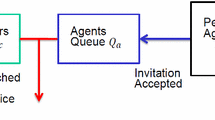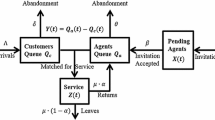Abstract
In addition to traditional call centers, companies have increasingly started developing a new type of customer contact center over the Internet, rather than using phone calls, where customers communicate with agents online through a website. Apart from lining up for an agent service, customers have the option of an interactive self-help response and thus can obtain faster service. In such a new customer contact center, managers are inclined to induce customers to use an automated service to reduce manpower costs. Under such circumstances, delay announcements play an important role in guiding customer behavior derived from an avoid-the-crowd option into a self-help choice. Motivated by this, we characterize the underlying stochastic processes by establishing a fluid model in overloaded regimes, and propose that the key to the model is a customer response resulting from system interactions based on a deterministic approximation. Furthermore, we prove that the fluid limit of the model is a unique solution to a complicated queueing system using differential equations. Based on numerical examples, the approximation is shown to be effective in overloaded regimes through comparisons with simulations.A key managerial insight is that the lower the service level is required for staffing, the more effective automated service and the guidance of delay announcement are.






Similar content being viewed by others
References
Abouee-Mehrizi H, Zare AG, Konrad R (2018) Pricing in service systems with rational balking and abandonment of time-sensitive customers. Production and operations management
Aguir M, Aksin O, Karaesmen F, Dallery Y (2008) On the interaction between retrials and sizing of call centers. Eur J Oper Res 191:398–408
Aguir MS, Karaesmen F, Aksin OZ, Chauvet F (2004) The impact of retrials on call center performance. OR Spect 26(3):353–376
Armony M, Shimkin N, Whitt W (2009) The impact of delay announcements in many-server queues with abandonment. Oper Res 57(1):66–84
Brandt A, Brandt M, Spahl G, Weber D (1997) Modelling and optimization of call distribution systems. Teletraffic Sci Eng 2:133–144
Chen H, Yao DD (2001) Fundamentals of queueing networks performance, asymptotics, and optimization. Springer-Verlag, New York
Cui L, Tezcan T (2016) Approximations for chat service systems using many-server diffusion limits. Math Oper Res 41(3):775–807
Ding S, Koole G, Mei R (2015) On the estimation of the true demand in call centers with redials and reconnects. Eur J Oper Res 246:250–262
Ding S, Remerova M, der Mei Van RD, Zwart B (2015) Fluid approximation of a call center model with redials and reconnects. Perform Eval 92:24–39
Ethier SN, Thomas GK (1986) Markov processes: characterization and convergence. Wiley, New York
Guo P, Zipkin P (2007) Analysis and comparison of queues with different levels of delay information. Manag Sci 53(6):962–970
Hassin R (1986) Consumer information in markets with random product quality: the case of queues and balking. Econometrica 54:1185–1195
Hui MK, Tse DK (1996) What to tell consumers in waits of different lengths: an integrative model of service evaluation. J Market 60(2):81–90
Ibrahim R, Whitt W (2009) Real-time delay estimation based on delay history. Manufac Serv Oper Manag 11(3):397–415
Ibrahim R, Whitt W (2009) Real-time delay estimation in overloaded multiserver queues with abandonments. Manag Sci 55(10):1729–1742
Ibrahim R, Whitt W (2011) Real-time delay estimation based on delay history in many-server queue with time-varying arrivals. Prod Oper Manag 20(5):654–667
Ibrahim R, Whitt W (2011) Wait-time predictors for customer service systems with time-varying demand and capacity. Oper Res 59(5):1106–1118
Ibrahim R, Armony M, Bassamboo A (2017) Does the past predict the future? The case of delay announcements in service systems. Manag Sci 63(6):1762–1780
Jouini O, Akşin Z, Dallery Y (2011) Call centers with delay information: models and insights. Manuf Serv Oper Manag 13(4):534–548
Khudyakov P, Feigin PD, Mandelbaum A (2010) Designing a call center with an IVR (interactive voice response). Queue Syst 66(3):215–237
Kumar A, Telang R (2012) Does the web reduce customer service cost? empirical evidence from a call center. Inf Syst Res 23(3):721–737
Legros B, Jouini O (2019) On the scheduling of operations in a chat contact center. Eur J Oper Res 274(1):303–316
Li S, Wang Q, Koole G (2019) Optimal contact center staffing and scheduling with machine learning. Working paper
Long Z, Tezcan T, Zhang J (2018) Customer service chat systems with general service and patience times. Social Science Electronic Publishing
Luo J, Zhang J (2013) Staffing and control of instant messaging contact centers. Oper Res 61(2):328–343
Macarena L, Pilar M (2008) A discrete time single-server queue with balking: economic applications. Appl Econ 40(6):735–748
Maister D, Czepiel JA, Solomon MR, Surprenant CF (1985) The service encounter: managing employee/customer interaction in service businesses Lexington Books. Lexington, MA
Munichor N, Rafaeli A (2007) Numbers or apologies? Customer reactions to telephone waiting time fillers. J Appl Psychol 92(2):511
Naor P (1969) The regulation of queue size by levying tolls. Econometrica 37:15–24
Reed J, Ward AR (2004) A diffusion approximation for a generalized jackson network with reneging. In: Proceedings of the 42nd annual Allerton conference on communication, control, and computing
Shae ZY, Garg D, Bhose R, Mukherjee R, Guven S, Pingali G (2007) Efficient internet chat services for help desk agents. In: IEEE international conference on services computing (SCC 2007), pp 589–596
Shin Y, Choo T (2009) M/m/s queue with impatient customers and retrials. Appl Math Modell 33:2596–2606
Srinivasan R, Talim J, Wang J (2004) Performance analysis of a call center with interactive voice response units. Top 12(1):91–110
Taylor S (1994) Waiting for service: the relationship between delays and evaluations of service. J Market 58(2):56–69
TELUS International (2011) Best practices: Online sales. White Paper, TELUS Communication Company, Canada
Tezcan T, Behzad B (2012) Robust design and control of call centers with flexible interactive voice response systems. Manufac Serv Oper Manag 14(3):386–401
Tezcan T, Zhang J (2014) Routing and staffing in customer service chat systems with impatient customers. Oper Res 62(4):943–956
Wang J, Cui S, Wang Z (2018) Equilibrium strategies in m/m/ 1 priority queues with balking. Production and operations management 28
Wang Q, Zhang B (2018) Analysis of a busy period queuing system with balking, reneging and motivating. Appl Math Modell 64:480–488
Whitt W (1999) Improving service by informing customers about anticipated delays. Manag Sci 45(2):192–207
Whitt W (2006) Fluid models for multiserver queues with abandonments. Oper Res 54(1):37–54
Xue M, Hitt LM, Harker PT (2007) Customer efficiency, channel usage, and firm performance in retail banking. Manufac Serv Oper Manag 9(4):535–558
Yankee Group (2006) Great expectations: Self-service success can happen. Report, Yankee Group, Boston, Available on http://www.ccng.com/files/public/Yankee_SelfService.pdf
Yom-Tov G, Mandelbaum A (2014) Erlang-r: a time-varying queue with reentrant customers, in support of healthcare staffing. Manufac Serv Oper Manag 16:283–299
Yu M, Tang J, Kong F, Chang C (2018) Fluid models for call centers with delay announcement and retrials. Knowl Based Syst 149:99–109
Zhang J, Zwart B (2008) Steady state approximations of limited processor sharing queues in heavy traffic. Queuing Syst 60(3–4):227–246
Zhang J, Dai J, Zwart B (2009) Law of large number limits of limited processor-sharing queues. Math Oper Res 34(4):937–970
Funding
This work was supported by National Natural Science Foundation of China [grant number 71701137, 61873174, 51678375], and Science Research Project of Liaoning Department of Education [grant number lnqn202029].
Author information
Authors and Affiliations
Corresponding author
Ethics declarations
Conflict of interest
No potential conflict of interest was reported by the authors.
Additional information
Publisher's Note
Springer Nature remains neutral with regard to jurisdictional claims in published maps and institutional affiliations.
Appendices
Appendix
First, for convenience regarding our analysis, the fluid scaled processes are defined as follows:
where \(\varLambda ^n\left( \cdot \right)\) is a Poisson process of \(\lambda n\). Next, we define the martingales related to the stochastic process.
Based on the definition above from Eq. (34) and (35), the fluid scaled stochastic dynamic equations can be written as follows:
Where
Proof of Lemma 1
To prove the C-tightness, we show that asymptotically the scaled processes \(\left\{ {{{{{\bar{Z}}}}^n}\left( \cdot \right) } \right. \left. {,{{{{\bar{A}}}}^n}\left( \cdot \right) } \right\}\) live on a compact set and have small oscillations. In addition, for the convenience of notation, let \({{\bar{X}}}_j^n\left( \cdot \right)\) simply denote the sequence of stochastic processes \(\left\{ {{{{\bar{Z}}}^n}\left( \cdot \right) ,{{{{\bar{A}}}}^n}\left( \cdot \right) } \right\}\), and \(j \in \left\{ {Z,A} \right\}\).
\(\bullet\) The compact containment condition: for any rational \(t \ge 0\) and any \(\varepsilon > 0\), there exists a compact set \({K_{\varepsilon ,t}} \subset S\) such that
\(\bullet\) The oscillation control : for any \(T > 0\) and \(\varepsilon > 0\), there exists a \(\eta > 0\) such that
Where, for a function \({{\bar{X}}}_j^n\left( \cdot \right) \in D\left( {{R_ + },S} \right)\)
First, the compact containment condition in Eq. (40) follows in easing by the upper bound, which holds for the total number of customers in the system, but only with arrivals.
\(\varLambda ^n\left( \cdot \right)\) is a Poisson process of \(\lambda n\), so we can obtain by the law of large number (LNN),
In addition, by Assumption 1, we can show that the compact containment property in Eq. (40) indeed holds: \({{\underline{\lim }} _{n \rightarrow \infty }}\mathrm{P}\left\{ {{\bar{X}}_j^n\left( t \right) \in {K_{\varepsilon ,t}}} \right\} \ge 1 - \varepsilon\), where \({K_{\varepsilon ,t}} = \left\{ {\left( {{x_1},{x_2}} \right) \left| {{x_1} + {x_2} \le z\left( 0 \right) + a\left( 0 \right) + \lambda T{{ + }}1,{x_1},{x_2} \ge 0} \right. } \right\}\).
Second, we establish the oscillation by Eqs. (16) and (17), since \(q \le 1\), \(\left( {1 - {p^b}\left( {{{{\bar{Z}}}^n}\left( t \right) - s} \right) } \right) \le 1\), then we have the following:
By applying the last two bounds together, we can give the following upper bound:
Based on the compact containment property, we can get a finite value such that
In this case, each part of \(\left( {{{{{\bar{Z}}}}^n}\left( t \right) ,{{{{\bar{A}}}}^n}\left( t \right) } \right)\) holds for \(v,t \in \left[ {0,T} \right]\). Such that \(\left| {t - v} \right| \le \eta\):
Thus, we can obtain
Finally, we can show the oscillation control property holds which a \(\eta > 0\) such that \(\lambda \eta < {\varepsilon \big / 4}\), \({r_J}\eta < {\varepsilon \big / 4}\), where \(J \in \left( {1,2,3} \right)\).
Proof of Theorem 1
Under Assumption 1, if Lemma 1 holds, we can obtain that the limit of any convergent subsequence satisfies Eqs. (16) and (17), then the key to the proof is a unique fluid limit defined by Eqs. (16) and (17).
Next, this step of the proof could be a general result like Theorem 1 in Ding et al. (2015b). First, by Lemma 1 in Reed and Ward (2004), we can show that the mapping \(\left( {{\beta _Z}\left( {{{{{\bar{Z}}}}^n}} \right) \left( t \right) ,{\beta _A}\left( {{{{{\bar{A}}}}^n}} \right) \left( t \right) } \right)\) is Lipschitz continuous, then combine with defined Eqs. (36) and (37), we can show Eqs. (43) and (44) have a unique solution with an arbitrary n,
Second, we may obtain that \(\left( {{{\bar{M}}}_Z^n\left( t \right) ,{\bar{M}}_A^n\left( t \right) } \right) \Rightarrow 0\) using LLN (see, for example Theorem 5.10 in Chen and Yao , 2001). That is, it can be shown that each term in \({{\bar{M}}}_Z^n\left( t \right)\) and \({\bar{M}}_A^n\left( t \right)\) converges to 0, such that \(\left( {{\bar{M}}_Z^n\left( t \right) ,{{\bar{M}}}_A^n\left( t \right) } \right) \Rightarrow 0\). Therefore, Eqs. (16) and (17) have a unique solution.
Rights and permissions
About this article
Cite this article
Yu, M., Zhao, Y., Chang, C. et al. Fluid models for customer service web chat systems with interactive automated service. Flex Serv Manuf J 35, 572–598 (2023). https://doi.org/10.1007/s10696-021-09442-7
Accepted:
Published:
Issue Date:
DOI: https://doi.org/10.1007/s10696-021-09442-7




